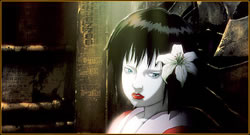
I like animation, in fact I even wrote a book about it. From my earliest memories of Disney and Looney Tunes, through to TV cartoons, such as HannaBarbera, all the way up to contemporary 3D marvels, the art and craft of animation has fascinated me. However, there has always been one criterion that overrides any of the techniques, and that is the story, or more specifically the script. No matter how good the visuals, if the story is weak, or in the case of cartoons, the humour doesn’t work, then it just becomes eye-candy, or worse.
Although I was raised on a diet of mostly American animation, I still clearly remember watching a Japanese TV show called Marine Boy, back in the 60’s. As I grew older my interest in animation waned in little, especially for those of Japanese origin, until I was alerted to Akira. Here was an amazingly drawn film with a great sci-fi story, but I still didn’t immerse myself into the whole anime culture. Anime is an acquired taste but, like ‘western’ animation, it has plenty of sub-genres and styles, so I just kept an eye out for things that looked interesting. Then along came Ghost in the Shell, with its tale of Cyborgs and computer networks that, like Akira, had both great artwork and story. The film’s influences on The Matrix are clearly visible, from the concepts to the titles to the action sequences.
Almost a decade on and the second GITS film is completed and it is even more visually stunning than the first, mostly due to advances in CGI. The story follows Bato, from the first film, as he and his new human partner investigate a series of murders conducted by female robot concubines, known as gynoids. Of course, the story is not really that simple, as it introduces concepts of spirituality, the human condition and government conspiracies, all wrapped up in a blend of hand-drawn 2D and CG animation.
 There are parallels that can be drawn with this sequel and the less-successful Matrix sequels, which are an overabundance of philosophy and too much reliance on CG to carry the story. Also, with so much happening on the screen, and the speed at which the dialogue is delivered, it is often quite difficult to keep up with the subtitles. While this may be sacrilege for the purists, watching a dubbed version may be preferable, which is where DVDs really come into their own, because you have a choice – and this film is already available on Region 1 DVD. The film is complex (and does stand alone), but it will take repeated viewings. In fact, I would recommend seeing it more than once to fully appreciate both its artistry and its message. See it first on a big screen for the full impact of the visual and aural spectacle, then get the DVD if you want to get a better grasp on what is happening.
There are parallels that can be drawn with this sequel and the less-successful Matrix sequels, which are an overabundance of philosophy and too much reliance on CG to carry the story. Also, with so much happening on the screen, and the speed at which the dialogue is delivered, it is often quite difficult to keep up with the subtitles. While this may be sacrilege for the purists, watching a dubbed version may be preferable, which is where DVDs really come into their own, because you have a choice – and this film is already available on Region 1 DVD. The film is complex (and does stand alone), but it will take repeated viewings. In fact, I would recommend seeing it more than once to fully appreciate both its artistry and its message. See it first on a big screen for the full impact of the visual and aural spectacle, then get the DVD if you want to get a better grasp on what is happening.
If you liked the first film then this one will definitely blow you away, just make sure your brain is fully engaged.
The film gets a limited UK release on October 28 at selected Cineworld and Picture House cinemas.

